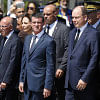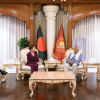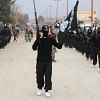Hard power and the war on terror in South Asia
Hard power or the coercive use of force has emerged as the most preferred tool in combatting terrorism in the post-9/11 era. Such an offensive security approach is premised on the belief that transnational terrorism, perpetrated by the al-Qaeda and the Islamic State of Iraq and Syria (ISIS), constitutes an act of irregular war, and by extension a national security threat, and therefore, military forces are better equipped to counter such threats. Interestingly, civilian law enforcement agencies are also following a national security paradigm in combatting terrorism, and as a direct consequence we are witnessing a progressive militarisation of the law enforcement agencies around the world.
The counterterrorism practices in South Asia, developed by international forces and their national counterparts, provide useful evidence to study the relevance of hard power. Let's begin with Afghanistan — the central battlefield in the US-led Global War on Terrorism. In Afghanistan the United States deployed up to 100,000 troops and its 40-plus NATO and non-NATO coalition partners deployed another 40,000 troops. Although the US and coalition forces withdrew from Afghanistan in 2014, nearly 10,000 foreign troops now operate in Kabul and other provinces to train and mentor the Afghan National Security Forces.
During the entire period of Afghanistan War (2001-present), the US and coalition forces played an instrumental role in developing a robust model for counterterrorism and counterinsurgency. In fact, the initial "enemy-centric" counterterrorism strategy was replaced with a "population-centric" counterinsurgency strategy. The difference between the two strategies is obvious: counterterrorism focuses on capturing or killing as many militants as possible, whereas counterinsurgency prioritises protecting civilian population centres by adopting a "clear-hold-build" approach. This "paradigm shift" in the Afghanistan War meant that the US and coalition forces were not only responsible for destroying terrorist strongholds but also for keeping control of those areas and carrying out development and reconstruction operations so that they could win the "hearts and minds" of the Afghan people.
Across the border, the Pakistani military and paramilitary forces were deployed in the Federally Administered Tribal Areas to seal off the Af-Pak borders so that the al-Qaeda and Taliban militias could not flee Afghanistan and find a safe haven in Pakistan. With the passage of time, the al-Qaeda and Taliban militias found a sanctuary in the Pashtun-dominated Pakistani tribal areas, and the Pakistani religious fundamentalists not only took control of the Swat Valley in Khyber Pakhtunkhwa province but also challenged the writ of the government in the heart of Islamabad by fiercely resisting the government forces at the Red Mosque.
The Pakistan government took a heavy-handed approach to suppress the Pakistani violent extremist groups, also known as the Tehrik-e-Taliban Pakistan (TTP), but maintained clandestine support for various Afghan Taliban groups such as Mollah Omar's Quetta Shura Taliban, Gulbuddin Hekmatyar's Hezb-e Islami, and Jalaluddin Haqqani Network. This has created a distrust in Washington, which has repeatedly warned Pakistan to cut off relations with the Afghan Taliban groups. Most Pakistan observers maintain that Islamabad wanted to support the Afghan Taliban groups in the hope that once US and coalition forces leave Afghanistan, they would regain some influence in the country and thus provide a strategic depth for Pakistan's nuclear arsenal and serve as a counterbalance against India.
Neither the United States nor its NATO allies had any comparable military role in combatting terrorism in the rest of South Asia. Yet, national governments in the region have frequently used the military forces to suppress terrorism and insurgency. For instance, the Indian security forces have long maintained a heavy-handed military approach to suppress militancy and insurgency in Kashmir and northeastern states. After the Lashkar-e-Taiba executed a terrorist attack in the Indian Parliament on September 13, 2001, the Indian government threatened to retaliate against Pakistan by amassing troops along the Pakistan border. Although the US crisis management diplomacy defused the tension, counterterrorism and counterinsurgency remain at the heart of Indian military doctrines. It was thus not surprising when the National Security Guard (NSG)—an Indian Special Operations Force—was deployed in response to the deadly terrorist attacks in Mumbai in 2008.
The Indian military forces also took the benefits of the global war on terrorism as a context to launch cross-border military operations in Bhutan and Myanmar in the pursuit of terrorists. In Sri Lanka, a militaristic strategy of the Sinhalese government played a crucial role in suppressing the Tamil insurgency. The same applies to Nepal, which used the military and paramilitary forces to combat the Maoist insurgency. In Bangladesh history, perhaps the army played its highest profile counterterrorism role during the Holey Artisan Bakery terrorist attack in Dhaka in 2016. The para commando battalion took the lead role in a hostage-rescue and counterterrorist operation, and all other security forces in the country provided support to make a successful conclusion of the Holey Artisan operation. In recent years, the small island state Maldives has also authorised its armed forces to play a proactive role in combatting terrorism and maritime piracy.
Aside from the direct role of the military forces in counterterrorism, civilian law enforcement agencies in the region are also adopting a militarised security posture and a tendency to participate in more and more high-risk operations in contrast to defensive patrolling and community policing. This is evident in the fact that nearly four dozen elite police units or paramilitary police units were established in South Asia in the post-9/11 era. The list of new and militarised police units includes but is not limited to ANCOP and CRU in Afghanistan; RAB and CTTC in Bangladesh; ATS, COBRA, and RAF in India; CTF and SCU in Pakistan; and STF in Sri Lanka. Media reports reveal that these paramilitary police units often wear military-like garb, carry offensive gear, and demonstrate a preference for the use of brute force in engaging terrorist suspects.
So what does the present terrorism threat landscape look like and what impact does it have on the use of hard power?
According to the Global Terrorism Index 2017, South Asia ranks as a region heavily affected by the impact of terrorism. The al-Qaeda, the Taliban, and the Khorasan chapter of ISIS are the major terrorist groups in the region. The affiliation of various homegrown terrorist groups with and their sympathetic attitudes towards al-Qaeda and ISIS also remain a major source of concern. After the killing of al-Qaeda leader Osama bin Laden, and the retreat of ISIS in Iraq and Syria, most of the foreign fighters are returning to their home countries magnifying the threat of foreign terrorist fighters. It is in this context that the military forces in Afghanistan and Pakistan, and the militarised police units in Bangladesh and India are likely to play a dominant role in countering Islamist violent extremism in the foreseeable future.
The use of hard power has often proved to be costly. This is evident in the loss of hundreds of lives by the security forces engaged in counterterrorism operations. Excessive use of force by the security forces has also led to many civilian casualties, and added fuel to the drivers of radicalisation. Critics have often called for relying more on soft power or the use of persuasion; the involvement of communities in de-radicalisation and rehabilitation of extremists; and rethinking the use of brute force in dealing with terrorism. Despite these shortcomings and the critiques, hard power is likely to remain a central component in the fight against terrorism. It is therefore important that security forces comply with the international human rights norms and maintain a strong oversight system to ensure the accountability of their operations.
ASM Ali Ashraf is Associate Professor of International Relations at the University of Dhaka and a member of the International Institute for Strategic Studies, London. Email: [email protected]










Comments